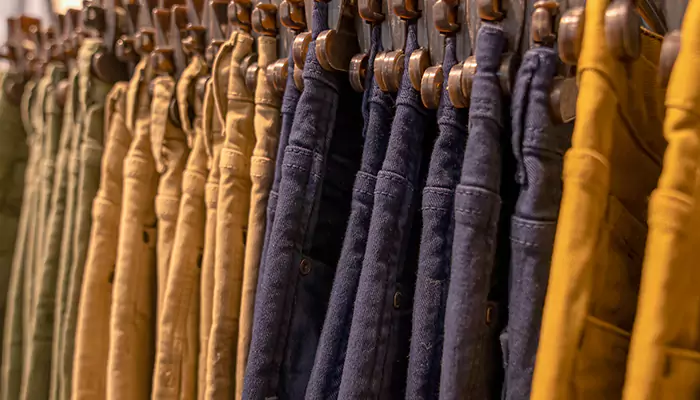
Cargo pants, once dismissed as strictly utilitarian or outdated, are back with a vengeance.
For decades, denim has been the undisputed foundation of everyday fashion—universally worn, endlessly adaptable, and culturally iconic. But in 2025, the monopoly of jeans and denim jackets is finally being challenged. A new wave of fabrics and silhouettes—cargo pants, corduroy tailoring, and utility-inspired wear—is reshaping what “casual dressing” means for modern consumers. This shift signals not the end of denim but a broadening of the everyday fashion landscape, driven by lifestyle changes, cultural influence, and evolving consumer priorities.
On recent runways in Paris and Milan, cargo trousers appeared in oversized silhouettes with exaggerated pockets, sleek tapered versions paired with heels, and even evening-appropriate iterations made from satin and leather.
The cargo revival is not accidental—it reflects today’s consumer demand for practicality blended with style. In an era where work, travel, and leisure blur together, clothing that offers comfort, flexibility, and utility feels inherently modern. Gen Z, in particular, has embraced cargos as part of streetwear culture, styling them with cropped tops, hoodies, and sneakers.
Retailers are responding quickly. High-street brands now offer cargos in every variation—low-rise, high-waist, wide-leg, and slim-fit—making them versatile enough to replace jeans as a go-to wardrobe essential.
Corduroy, long associated with vintage aesthetics or academic dressing, has found fresh relevance in 2025. Designers are reimagining the ridged fabric in sleek tailoring, oversized blazers, structured skirts, and even outerwear. The shift is subtle but significant: corduroy is no longer treated as nostalgic but as a symbol of modern craftsmanship and tactile luxury.

Part of corduroy’s comeback is its versatility. Unlike denim, which leans casual, corduroy adapts seamlessly to smart-casual and professional settings. A corduroy suit in deep olive or burgundy can serve as both workwear and evening attire, while corduroy trousers paired with oversized knits tap into the cozy-yet-chic aesthetic dominating lifestyle dressing.
Importantly, corduroy also aligns with sustainability narratives. The fabric’s durability and timeless appeal make it ideal for investment dressing, resonating with consumers seeking pieces that last longer than fast-fashion cycles.
Beyond specific fabrics, the broader rise of utility wear underscores a cultural moment. Multi-pocket jackets, boiler suits, tactical vests, and adjustable belts are not just trends—they are reflections of a world increasingly focused on adaptability and resilience. The “utility” aesthetic speaks to the desire for clothing that is both functional and expressive, allowing wearers to balance style with preparedness.
This is also where fashion intersects with technology and performance. Utility-inspired pieces now incorporate technical fabrics like water-resistant nylon, recycled polyester, and thermal cotton blends. The result is fashion that adapts to varied climates, supports active lifestyles, and aligns with the sustainability expectations of younger consumers.
Denim isn’t disappearing, but its once-unchallenged dominance is waning. Global denim sales growth has plateaued in recent years, while alternative fabrics are seeing double-digit increases, particularly in urban markets. The diversification of everyday wear reflects both consumer fatigue with denim’s ubiquity and a broader appetite for experimentation.

Social media also plays a key role. Influencers and celebrities are spotlighting cargos, corduroy, and utility wear as fresh alternatives to jeans, encouraging consumers to expand their daily wardrobes. In effect, denim now coexists with an expanded toolkit of casual options rather than defining casualwear on its own.
Retailers are already adjusting strategies. E-commerce platforms highlight “beyond denim” edits, while global chains are dedicating floor space to cargos and corduroy collections. Luxury brands, meanwhile, are elevating these fabrics through premium materials and sharp tailoring, further pushing them into aspirational territory.
Looking ahead, the everyday fashion market is expected to diversify even further. Analysts predict hybrid collections—such as corduroy infused with stretch fibers or cargos made from sustainable silks—will become common as brands cater to both comfort and luxury demands.
In 2025, denim remains a staple, but no longer the sole authority on casual fashion. Cargo pants, corduroy tailoring, and utility wear have entered the mainstream, offering fresh possibilities that combine function, sustainability, and style. This shift isn’t just about clothing—it reflects a cultural evolution where versatility and individuality are prized over uniformity.
As consumers experiment with these alternatives, everyday fashion is becoming richer, more diverse, and more personal than ever before. Denim may never disappear, but the future of casualwear belongs to a broader, more exciting palette of fabrics and silhouettes.